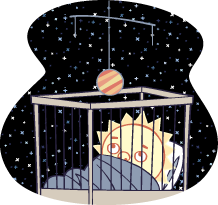





Once upon a time there was a Big Bang. Before the beginning there was nothing nowhere. Not a vacuum, or like the empty half of a half empty glass, (or half full, depending on your bent) more like an empty glass that didn’t exist and no place to put it. This nothing nowhere exploded into everything everywhere which couldn’t have been caused by anything because there wasn’t anything.
So, the entire universe is an effect without a cause. Which is magical science, hence the fairy tale style opening. Anyway, the laws of nature don’t apply in the case of the creation of everything. After all, the laws of nature didn’t exist yet, either.
After this initial creation miracle event things really began hotting up. A phantasmagoria of gazillions of super-excited bits all atwitter grew in hyper fashion. Once a thing like this gets a notion to expand infinitely at near warp speed it’s pretty hard to apply the brakes. They call this the inflation of the universe because it’s a lot like monetary inflation which is caused by creating money from nothing.

Early on, Space and Time put together a continuum enacting a speed limit for light and rules for the conservation of energy. It’s hard to see why it needed conserving as the universe contained more energy than you could shake a stick at. (I don’t imagine shaking a stick at a universe full of energy would accomplish much though.) But the Space-Time Continuum was saving up as it intending to last forever and ever. How much longer forever and ever is than just plain forever is hard to make out. Some folks are never satisfied, even though enough is enough.
The Space-Time Continuum then passed the laws of gravity and motion. To enforce the laws they assembled a bunch of Newtonian Principals who outlawed perpetual motion machines. Some people still try to make and sell these outlawed devices, but the arms of the laws of physics are really long and the machines only work outside the known universe, which is very hard to get to.

The continuum also hired Quantum Mechanics to work out the working parts of this business. Early on there was dissension in the ranks, the Mechanics didn’t agree with the Principals so they made up their own rules. This meant the universe worked two ways which didn’t mesh. So the Space-Time Continuum simply came up with the Uncertainty Principle so things worked one way or the other, depending on which was more convenient at the time. Whether or not this is intelligent design is uncertain.
Fast-forward a million years, give or take a millennium, things were still on the chaotic side. The Newtonian Principals began gathering together and organizing things by enforcing the law of Gravity. A very serious law, and hence the name. Why the Newtonian Principals chose gravity as the means to organize the universe is something of a quandry since gravity is the weakest force available for such an enormous place like the universe. In fact, there was a 90% shortage of gravity to make it work.


To get around the shortage they commissioned General Relativity to bend the fabric of Space-Time into military shape. The good general issued new orders encrypted in calculus so no-one could see the inherent errors in them. By these means great gobs of dark matter were devised to make up the gravity deficit. Even so, the space bits moved around in defiance of orders. So the general conjured up dark energy to save the situation, and the theory. It’s very easy to explain things if you can just make stuff up. That’s how General Relativity does it, and so will we.
Returning to our story, organizing the cosmos into exotic shapes like cones or pyramids may have been tried, but if you’ve ever tried to herd cats or shove hyper charged particles about you can understand why the “keep it simple, stupid” school prevailed. In the end (the beginning really) the consensus was that a ball was just the ticket. Cubes were right out because, as Einstein said, “God doesn’t play dice with the universe.” Even though he said it a long time after the fact.
So balls it would be. Balls are uniform any way you look at them and can be used for all sorts of fun and games. Plus no particles get stuck in a corner feeling left out and so join in the fun. If a ball gets big enough you can make a planet. A planet can have plants and animals and people who can start societies, civilizations, and governments and generally muck things up if they’re not careful. People can also make lots of other, though admittedly much smaller balls: baseballs, soccer balls, basketballs, and footballs, which aren’t shaped like balls at all.
In some cases there seemed to be a want of leadership and instead of anything cohesive particles congregated into great amorphous masses which succeeded only in turning chaos into anarchy. These space blobs are called nebula, plural for nebulous, meaning “not shaped like anything in particular.” (Probably something from Greek or Latin, as is often the case.) So a nebula is shaped like a group of shapeless shapes, or something. I don’t get it and neither do the particles that make one up, which may explain it.
At some point General Relativity realized the added dark matter and dark energy couldn’t get all the shapeless shapes organized to obey orders so he scattered around some magnetic fields to direct traffic. Applying the same rules of the Big Bang, these magnetic fields exist without anything causing them, like an electric current or maybe dark bar magnets. At any rate, electro-magnetism is for electricians so the good general doesn’t bother himself with such trifles.
The ball-making mania spread like wildfire as far as the eye could see, actually, farther than the eye could see. As the balls grew bigger and bigger they got overcrowded and all the bits started rubbing up against each other causing a great deal of friction and hot tempers which made the balls heat up and start glowing white hot. This is how stars are born, considering their size and temperature this birthing would be mighty painful. But Mother Nature doesn’t seem to mind giving birth to a star one minute and tending to the birds and bees the next.

Sometimes the mad rush to the center was overdone and the particles got mushed up collapsing into what’s called a black hole. This is an entire star reduced to the size of a single point, a coördinate without dimension. In other words, well, nothing. This is absurd on the face of it, but then a black hole doesn’t have a face so it’s OK.
To make black holes the Quantum Mechanics grant a special exemption, called a singularity, so pathetically weak gravity overpowers the more powerful atomic force that keep atoms the proper shape. This is done with division by zero to get infinity. This wanton disregard for the laws of physics and math is what makes the universe as we know it possible. After all, they wrote the laws so they can write the loopholes to get around them. We soldier on.
Stars like our sun seem to be all warm and friendly, spreading light and generally making life pleasant, but this is at a distance. Up close a star is like a living hell. It’s so hot the particles have to keep moving to escape the heat. But it’s so crowded the bits smash into each other fusing together making bigger particles. This is called fusion. (You’d think it’d be called fusing, what can I tell you?) Dash a couple hydrogens together and you get helium. Shove in another and you get… something bigger. This is how heavy elements are made. Pretty much alchemy on a vast scale.

In cases where there wasn’t enough matter to make a star the chunks of matter were gathered into smaller balls, though still pretty big by ball standards. These balls didn’t have enough friction or excitement to become stars. (We can’t all be stars.) These balls would be planets, and in fact are.
Planets are law-abiding souls, unlike the people that might populate them, as you know if you watch COPS. One law they really abide is the law of gravity, which says everything is drawn to everything else, where you are I want to be, so come here. Which reads more like a bad song lyric, but that’s the gist of it. Planets are very attracted to stars and desperately want to get to them. They’re like groupies, Sun worshipers in the case of our solar system. So they fling themselves at the stars with reckless abandon, little realizing the stars would chew them up and spit them out without a second thought.
Now, everything in space is going at super fast speeds over super vast distances, though you wouldn’t know it to look at it. If the planet’s aim is off, or the star sidesteps, it passes right by. The speeding planet can’t turn fast enough and so goes round and round the star never managing to catch it, whirling about like a moth to a flame, feeding off the warm glow and glamour of it all.
Some debris balls never get up to planet size. Too small to get a star’s attention, they hook up with a planet figuring they can sneak in with it when the star isn’t looking. These are satellites, or moons depending how romantic the planets feel about them.
Even smaller chunks became what we call meteors or comets. What beings on other planets call them is unknown. These meteors have no minds of their own and will go for anything, wander anywhere and get pulled into whatever comes close or catches their fancy. Very fickle and unreliable these meteors, they’ll ditch a star or a planet at the drop of a hat, if the hat is big enough.
All this congregating and building-uping and running around eventually turned into the stable solar system we enjoy today. If you don’t enjoy it, shame on you. This despite that complex multi-object systems can only stabilize with a feedback mechanism which General Relativity and the Newtonian Principals failed to include. Then again, since a lot of what we covered so far doesn’t really make sense, we won’t let this minor oversight bother us either.

The Continuum next gathered up various planetary systems into a series sort-of space empires called a galaxy, from the Greek galaxi meaning a big bunch of stars. Bit of circular logic there, but so it goes. Organizational plans, such as picturesque figure eights, cloverleafs, mobius strips, and other exotic shapes might have been considered, but General Relativity had enough to do without having to co-ordinate all that. He decided either a twirling pancake or a pinwheel shape was just the ticket. Plus, these arrangements required no additional training for the balls as they already knew how to go in circles.
Meanwhile the Quantum Mechanics were busy working out the details. Their solutions were not so simple because it’s very hard working with particles too small to see and so full of energy that once you corral one it splits or makes a quantum jump or something equally disruptive. They took the opposite tack of the Newtonian Principals or General Relativity, instead of merging things ever bigger, they kept dividing things up ever smaller. They came up with the atom. Atom is Greek for indivisible, which they ignored dividing atoms up into neutrons, protons, and electrons anyway. They tossed in a weak force, a strong force, and electro-magnetism to give it some kick.
All this was managed with a set of work rules that take entire books and rooms full of physicists to explain. And even then you probably won’t understand them. Well, I don’t anyway.



They arranged the atoms with the electrons orbiting like mad on the outside. Protons and neutrons were shoved together in the center, called the nucleus. The protons have all the power, the neutrons just add ballast, without which people wouldn’t weigh enough and would go floating off into space, which is not a people friendly environment. Neutrons are like protons that have been neutered, hence the name. The protons and neutrons love each other and stick together like white on rice. Never try to break up a nucleus or you’ve got big trouble on your hands. The kind of trouble atomic bombs are made for.
The real action takes place with the electrons even though they are runts compared to the nucleus. But what they lack in size they make up in boundless energy, whizzing about constantly hooking up with electrons from other atoms making bonds and dates for week-ends on the town. They’re players. Most nuclei don’t mind sharing electrons with other nuclei as long as they share back. For atoms it’s all one big swinging scene. While some share eagerly, others must be forced into it with heated pressure, or persuaded with bribes brokered by outsider atoms called catalysts. Catalysts pay a price in electrons to see other atoms bond without getting in on the action. They’re like voyeurs or silent partners or just plain suckers, also known as investors.


All of this bonding and sharing means you can combine various atoms together like Lego blocks to build things atoms can’t manage on their own. For instance, you can combine two hydrogens and an oxygen into water. These combinations are called molecules, the old greek term for Lego blocks. Combining the resulting molecules together makes more complex things like DNA, bakalite, or a house made of Lego blocks, which takes a whole lot of molecules so you wouldn’t want to put them together one at a time.
There are also anti-protons, anti-neutrons and anti-electrons. Anti-particles are against everything the other atomic bits are for. They’re like anarchists and should one of the anti-particles catch a pro-particle they blow themselves up taking the pro-particles with them. If you see an anti-particle coming your way, run.
In addition there are other oddly named particles like positrons, photons, leptons, muons and morons. The positrons are very clever and can be assembled to make a positronic brain. Photons are handy for making torpedoes to blow up Klingon raiders and other pesky, and usually unsightly aliens. The leptons and muons are fairly useless as far as I know. But it only takes one moron to break a positronic brain, so by all means never loan one your laptop.



Just to make it more complex the Quantum Mechanics came up with what they called the quark. Not one type, but six quarks which they dubbed: up, down, top, bottom, strange, and charmed. The difference between these varieties is… I have no idea.
Not to be outdone by General Relativity, the Quantum Mechanics decided they needed some crazy physics of their own. They invented the God particle, which sounds suspiciously more like religion than science. Then there’s cases of particles said to move forward in space and backward in time. A statement which makes syntactical sense but no real sense, like the Dada exquisite corpse, “Furious, green sleep aged diagonally.”
The topper at the bottom of all this, to mix a metaphor, is the idea recently floated that all of the various bits are made of differently shaped vibrating strings. This idea is called String Theory which is the Quantum Mechanics attempt to simplify everything into a neat little package, tied together with vibrating strings apparently. How it all works or how many strings can vibrate on the head of a pin is anyone’s guess. The thing about String Theory is, because the strings are so micro-nano, itsy-bitsy, teeny-tiny it’s fairly impossible to prove or disprove.
It’s difficult to explain how this all fits together, either because I have no idea or it actually doesn’t. Understanding current astrophysics requires one believing the bizarre is common and nonsense is sensible. It just takes some special training in understanding the unintelligible. This is available at institutes of higher learning all over the world. Or simply follow the advice of the Queen of Hearts in Through the Looking Glass:
Alice laughed. “There’s no use trying,” she said “One can’t believe impossible things.”
“I daresay you haven’t had much practice,” said the Queen. “When I was your age, I always did it for half-an-hour a day. Why, sometimes I’ve believed as many as six impossible things before breakfast.”
Nevertheless, what we wind up with is thermo-dynamics, electro-magnetism, gravity and whatnot. The bottom line is, thanks to engineers more than physicists, you can heat your house and run a blender to make yourself a nice daiquiri to sip as you sit in your lawn chair beneath the night sky pondering the wonder of it all without floating off into space. Or maybe wonder what the heck it is I’m talking about.
In any case, even in the unlikely event you do understand it the way I tell it, it’s of little help paying your heating, electric, and liquor bills. Unless you’re a physicist or astronomer making the tall dollars from government grants to mis-explain the inexplicable. In which case, never mind.
© Terry Colon, 2010